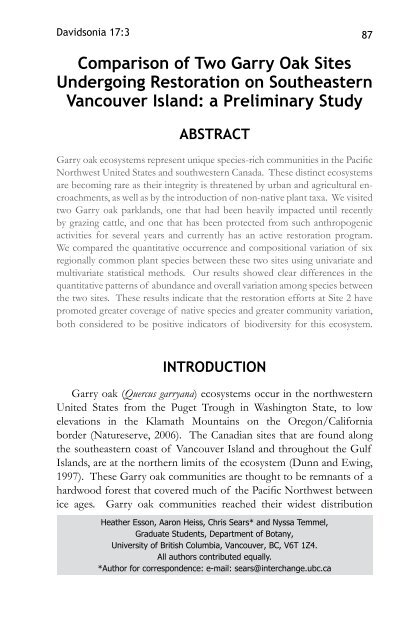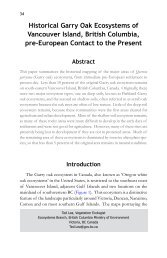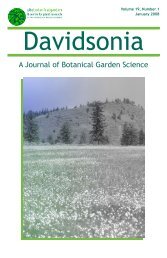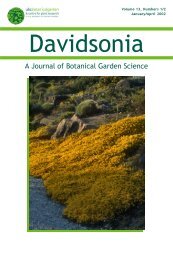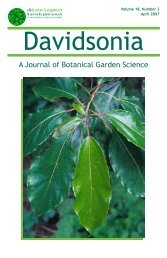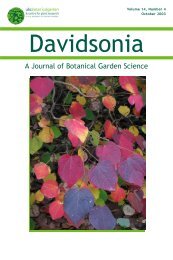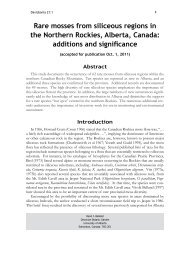Viscin Cells in the Dwarf Mistletoe Arceuthobium ... - Davidsonia
Viscin Cells in the Dwarf Mistletoe Arceuthobium ... - Davidsonia
Viscin Cells in the Dwarf Mistletoe Arceuthobium ... - Davidsonia
- No tags were found...
You also want an ePaper? Increase the reach of your titles
YUMPU automatically turns print PDFs into web optimized ePapers that Google loves.
<strong>Davidsonia</strong> 17:3 87<br />
Comparison of Two Garry Oak Sites<br />
Undergo<strong>in</strong>g Restoration on Sou<strong>the</strong>astern<br />
Vancouver Island: a Prelim<strong>in</strong>ary Study<br />
ABSTRACT<br />
Garry oak ecosystems represent unique species-rich communities <strong>in</strong> <strong>the</strong> Pacific<br />
Northwest United States and southwestern Canada. These dist<strong>in</strong>ct ecosystems<br />
are becom<strong>in</strong>g rare as <strong>the</strong>ir <strong>in</strong>tegrity is threatened by urban and agricultural encroachments,<br />
as well as by <strong>the</strong> <strong>in</strong>troduction of non-native plant taxa. We visited<br />
two Garry oak parklands, one that had been heavily impacted until recently<br />
by graz<strong>in</strong>g cattle, and one that has been protected from such anthropogenic<br />
activities for several years and currently has an active restoration program.<br />
We compared <strong>the</strong> quantitative occurrence and compositional variation of six<br />
regionally common plant species between <strong>the</strong>se two sites us<strong>in</strong>g univariate and<br />
multivariate statistical methods. Our results showed clear differences <strong>in</strong> <strong>the</strong><br />
quantitative patterns of abundance and overall variation among species between<br />
<strong>the</strong> two sites. These results <strong>in</strong>dicate that <strong>the</strong> restoration efforts at Site 2 have<br />
promoted greater coverage of native species and greater community variation,<br />
both considered to be positive <strong>in</strong>dicators of biodiversity for this ecosystem.<br />
INTRODUCTION<br />
Garry oak (Quercus garryana) ecosystems occur <strong>in</strong> <strong>the</strong> northwestern<br />
United States from <strong>the</strong> Puget Trough <strong>in</strong> Wash<strong>in</strong>gton State, to low<br />
elevations <strong>in</strong> <strong>the</strong> Klamath Mounta<strong>in</strong>s on <strong>the</strong> Oregon/California<br />
border (Natureserve, 2006). The Canadian sites that are found along<br />
<strong>the</strong> sou<strong>the</strong>astern coast of Vancouver Island and throughout <strong>the</strong> Gulf<br />
Islands, are at <strong>the</strong> nor<strong>the</strong>rn limits of <strong>the</strong> ecosystem (Dunn and Ew<strong>in</strong>g,<br />
1997). These Garry oak communities are thought to be remnants of a<br />
hardwood forest that covered much of <strong>the</strong> Pacific Northwest between<br />
ice ages. Garry oak communities reached <strong>the</strong>ir widest distribution<br />
Hea<strong>the</strong>r Esson, Aaron Heiss, Chris Sears* and Nyssa Temmel,<br />
Graduate Students, Department of Botany,<br />
University of British Columbia, Vancouver, BC, V6T 1Z4.<br />
All authors contributed equally.<br />
*Author for correspondence: e-mail: sears@<strong>in</strong>terchange.ubc.ca


